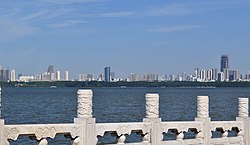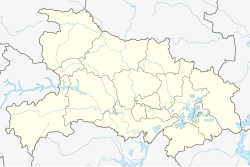Wuchang
武昌区 Wu-Chang | ||||||||||||||||||||||||||||||||||||
|---|---|---|---|---|---|---|---|---|---|---|---|---|---|---|---|---|---|---|---|---|---|---|---|---|---|---|---|---|---|---|---|---|---|---|---|---|
 East Lake overlooking Wuchang | ||||||||||||||||||||||||||||||||||||
 | ||||||||||||||||||||||||||||||||||||
| Coordinates: 30°33′43″N 114°20′25″E / 30.5619°N 114.3404°E[1] | ||||||||||||||||||||||||||||||||||||
| Country | People's Republic of China | |||||||||||||||||||||||||||||||||||
| Province | Hubei | |||||||||||||||||||||||||||||||||||
| Sub-provincial city | Wuhan | |||||||||||||||||||||||||||||||||||
| Area | ||||||||||||||||||||||||||||||||||||
| • Total | 87.42 km2 (33.75 sq mi) | |||||||||||||||||||||||||||||||||||
| Population (2010)[3] | ||||||||||||||||||||||||||||||||||||
| • Total | 1,199,127 | |||||||||||||||||||||||||||||||||||
| • Density | 13,717/km2 (35,530/sq mi) | |||||||||||||||||||||||||||||||||||
| Time zone | UTC+8 (China Standard) | |||||||||||||||||||||||||||||||||||
| Wuhan district map |
| |||||||||||||||||||||||||||||||||||
| Website | 武昌区政府门户网站 (translation: Wuchang District Government Web Portal (in Simplified Chinese) | |||||||||||||||||||||||||||||||||||
| Wuchang, Wuhan | |||||||||
|---|---|---|---|---|---|---|---|---|---|
 Changchun Temple | |||||||||
| Traditional Chinese | 武昌 | ||||||||
| |||||||||
Wuchang is one of 13 urban districts of the prefecture-level city of Wuhan, the capital of Hubei Province, China. It is the oldest of the three cities that merged into modern-day Wuhan, and stood on the right (southeastern) bank of the Yangtze River, opposite the mouth of the Han River. The two other cities, Hanyang and Hankou, were on the left (northwestern) bank, separated from each other by the Han River.
The name "Wuchang" remains in common use for the part of urban Wuhan south of the Yangtze River. Administratively, however, it is split between several districts of the City of Wuhan. The historic center of Wuchang lies within the modern Wuchang District, which has an area of 82.4 square kilometres (31.8 sq mi) and a population of 1,003,400.[4] Other parts of what is colloquially known as Wuchang are within Hongshan District (south and south-east) and Qingshan District (north-east). Presently, on the right bank of the Yangtze, it borders the districts of Qingshan (for a very small section) to the northeast and Hongshan to the east and south; on the opposite bank it borders Jiang'an, Jianghan and Hanyang.
On 10 October 1911, the New Army stationed in the city started the Wuchang Uprising, a turning point of the Xinhai Revolution that overthrew the Qing dynasty and established the Republic of China.
- ^ "Wuchang" (Map). Google Maps. Retrieved 2014-07-02.
- ^ "Wuhan Statistical Yearbook 2010" (PDF). Wuhan Statistics Bureau. p. 15. Retrieved 2011-07-30.
- ^ 武汉市2010年第六次全国人口普查主要数据公报 (in Simplified Chinese). Wuhan Statistics Bureau. 2011-05-11. Archived from the original on 2011-10-25. Retrieved 2011-06-11.
- ^ "Profile of Wuchang District" (in Chinese). official website of Wuchang District Government. Archived from the original on 2008-03-24. Retrieved 2008-04-19.

